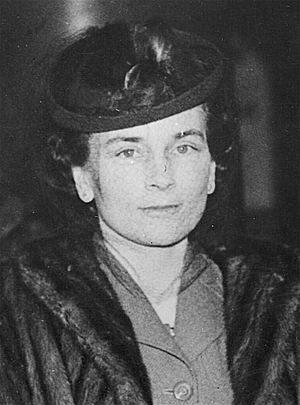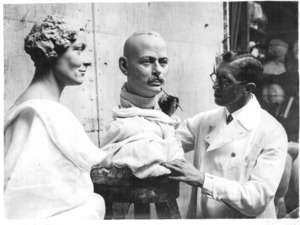Princess Alice, Duchess of Gloucester facts for kids
Quick facts for kids Princess Alice |
|
|---|---|
| Duchess of Gloucester (more) | |

Alice in 1945
|
|
| Born | Alice Christabel Montagu Douglas Scott 25 December 1901 Montagu House, London, England |
| Died | 29 October 2004 (aged 102) Kensington Palace, London, England |
| Burial | 5 November 2004 Royal Burial Ground, Frogmore, Windsor, Berkshire, England |
| Spouse | |
| Issue | |
| House | Montagu Douglas Scott |
| Father | John Montagu Douglas Scott, 7th Duke of Buccleuch |
| Mother | Lady Margaret Bridgeman |
| Viceregal Consort of Australia | |
| In role 30 January 1945 – 11 March 1947 |
|
| Monarch | George VI |
| Governor General | Prince Henry, Duke of Gloucester |
| Preceded by | The Countess of Gowrie |
| Succeeded by | Mary, Lady McKell |
Princess Alice, Duchess of Gloucester (born Lady Alice Christabel Montagu Douglas Scott; 25 December 1901 – 29 October 2004) was a member of the British royal family. She was the wife of Prince Henry, Duke of Gloucester, who was the third son of King George V and Queen Mary. This made her a sister-in-law to Edward VIII and George VI, and an aunt by marriage to Elizabeth II.
Princess Alice was the mother of Prince William of Gloucester and Prince Richard, Duke of Gloucester. She was known for her extensive travels both before and after her marriage. When she passed away at 102 years old, she was the longest-living member of the British royal family ever.
Contents
Early Life and Adventures
Alice Christabel was born in Montagu House, Whitehall, London, on Christmas Day 1901. She was the fifth child of John Montagu Douglas Scott, who later became the 7th Duke of Buccleuch, and his wife, Lady Margaret Alice Bridgeman. Because she was born on Christmas Day, she was given the middle name Christabel.
Alice spent her childhood moving between several grand family homes in Northamptonshire and Scotland. One of her main homes was Eildon Hall in Melrose, Scottish Borders. When she was 14, she had a scary experience where she almost drowned. This made her realize how important it was to make the most of every day.
She attended St James's School for Girls in West Malvern, Worcestershire. After school, she traveled a lot, visiting France, Kenya, and India. She spent a year in Paris before being formally introduced to society at Court in 1920. Alice loved outdoor activities like skiing, horse-riding, and hunting. She was also a talented painter with watercolors. One of her paintings, done in Kenya, is now part of the Royal Collection.
Royal Marriage
In 1935, Lady Alice returned to the United Kingdom because her father's health was getting worse. In August 1935, she became engaged to Prince Henry, Duke of Gloucester. They were married in a private ceremony at the Private Chapel in Buckingham Palace on 6 November 1935.
A much larger wedding was originally planned for Westminster Abbey. However, because her father passed away shortly before the wedding, and due to the King's own health issues, they decided to have a smaller, more private ceremony.
Princess Alice wore a unique blush-colored wedding gown, making her the only British royal bride to do so. Her dress was designed by Norman Hartnell, who also designed the future Queen Elizabeth's wedding dress. The day of her wedding was cold and wet, but over a million people still lined the streets to see the couple. Because of the cold weather, she wore an "ermine blanket stole" and was often called the "Winter Princess" from then on.
Life in the Royal Family
After their marriage, the Duke and Duchess of Gloucester first lived at the Royal Pavilion in Aldershot. Prince Henry left the army to take on more royal duties after his brother, Edward VIII, stepped down from the throne in 1936.
The couple was given York House, St James's Palace in London as a home. In 1938, they bought Barnwell Manor in Northamptonshire. Princess Alice had two sons:
- Prince William of Gloucester (born 18 December 1941, died 28 August 1972)
- Prince Richard, Duke of Gloucester (born 26 August 1944). He married Birgitte van Deurs Henriksen in 1972.
The Duke and Duchess of Gloucester traveled a lot for their royal duties. During World War II, Princess Alice worked with the Red Cross and the Order of St John. She became the head of the Women's Auxiliary Air Force (WAAF) in 1939. She was promoted several times, eventually becoming an Air Chief Marshal in the Royal Air Force in 1990.
From 1945 to 1947, the Duke and Duchess lived in Canberra, Australia, where Prince Henry served as Governor-General of Australia.
In 1965, the Duke was involved in a car accident. Princess Alice later wrote that she must have fallen asleep, and the car ended up upside down in a field. Prince Henry was thrown from the car.
In 1972, Princess Alice's older son, Prince William, tragically died in a plane crash during an air show race. Her husband, Prince Henry, was very unwell at the time. Princess Alice later said she didn't tell him directly about William's death, but he might have learned from television. Prince Henry passed away on 10 June 1974.
Later Life and Longevity
In 1975, Princess Alice became the first woman to be appointed a Dame Grand Cross of the Order of the Bath. She published her memoirs, The Memoirs of Princess Alice, Duchess of Gloucester, in 1981, and a revised edition, Memories of Ninety Years, in 1991.
In 1994, Princess Alice moved from Barnwell Manor to Kensington Palace to live with her son, Prince Richard, and his wife. She officially retired from public duties at the age of 98. In 1999, it was announced that she would no longer carry out public engagements outside Kensington Palace due to her health.
In December 2001, the royal family celebrated Princess Alice's 100th birthday with a special ceremony. This was her last public appearance. After Queen Elizabeth The Queen Mother passed away in March 2002 at 101, Princess Alice became the oldest living member of the British royal family. On 21 August 2003, she became the longest-lived person in the history of the British royal family, surpassing the Queen Mother's record. She was even certified by Guinness World Records as the world's longest-lived royal of all time.
Death and Legacy
Princess Alice died peacefully in her sleep at Kensington Palace on 29 October 2004, at the age of 102 years and 309 days. After her death, the Union Jack flag flew at half-mast at Buckingham Palace.
Her funeral was held on 5 November 2004, at St George's Chapel, Windsor. She was buried next to her husband, Prince Henry, and her elder son, Prince William, at the Royal Burial Ground, Frogmore. Many members of the British royal family, including Queen Elizabeth II, attended the funeral.
Princess Alice was known as a very private person. She was also known for her quiet sense of humor. Once, when told her drawing-room floor couldn't hold more than twenty people, she joked that they made a party list of the "twenty-one people whom we disliked most."
After her son William's death, Queen Elizabeth The Queen Mother said Princess Alice had "the courage of a lion." Princess Alice herself admitted that after her son's death, she was "completely stunned and have never quite been the same since."
Titles and Styles
- 25 December 1901 – 5 November 1935: Lady Alice Montagu Douglas Scott
- 6 November 1935 – 10 June 1974: Her Royal Highness The Duchess of Gloucester
- 10 June 1974 – 29 October 2004: Her Royal Highness Princess Alice, Duchess of Gloucester
When her husband, Prince Henry, died in 1974, their second son, Prince Richard, became the new Duke of Gloucester. Princess Alice asked her niece, the Queen, if she could use the title HRH Princess Alice, Duchess of Gloucester. This was allowed to avoid confusion with her daughter-in-law, the new Duchess of Gloucester.
Images for kids
See also
 In Spanish: Alicia de Gloucester para niños
In Spanish: Alicia de Gloucester para niños







